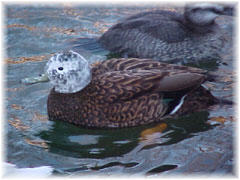
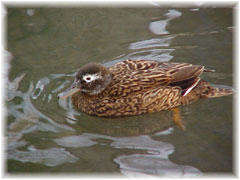
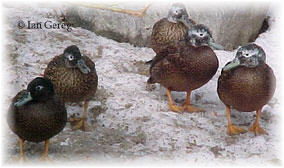
Laysan
Teal:
Native to Laysan Island only and believed to be an isolated form of
the mallard. First discovered in 1882 and has been on the verge of
extinction a number of times. Only six were found in 1911. Captive
breeding has brought the species back from the brink.
 |
 |
 |
| Laysan Teal Drake | Laysan Teal Hen | Laysan Teal Flock |
Chestnut
Teal:
This Australian teal rarely leaves the water, preferring to feed on
the water but is also often seen running quite easily during the breeding season
while looking for suitable nesting sites. A teal of coastal regions with
hollow trees as the most common nesting sites.
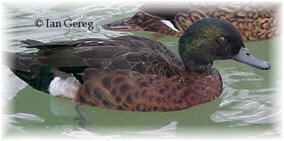 |
||
| Chestnut Teal Drake |
Baikal
Teal:
Not a great deal of information is known about this Siberian teal in
the wild, however, the wild numbers are declining because of excessive hunting
and the draining of marshland for agriculture. It was at one time very
abundant.
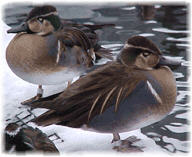 |
| Baikal Teal Drakes |
Falcated
Duck:
A Siberian duck that resembles a man in a tuxedo when the males are
in full breeding plumage. The duck is little known in the wild because it
is very shy and elusive, making it difficult to study its habits.
Sharpwing
Teal:
The South American Sharpwing has the most southern distribution of
all the teal, living in Argentina and the Falkland Islands. It is skilled
at perching in trees to evade predators, and it is agile enough to maneuver
through the canopy of trees.
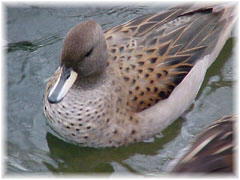 |
| Sharpwing Teal Drake |
Green
Winged Teal:
The smallest duck native to North America, which is breeding
throughout Canada, Alaska, and the northern continental United States. It
is also an extreme fast flier.
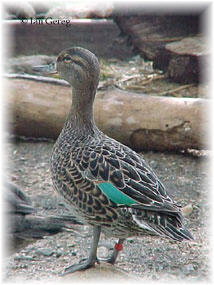 |
||
| Green Winged Teal Hen |
European
Widgeon:
The European duck is adept at grazing on short grasses, almost like
geese, and is most often seen in small groups, preferring not to mingle with
other species.
American
Widgeon:
This North American widgeon prefers fresh water more than the
European widgeon, but it is adept at grazing like the European. It also
often steals food from diving ducks like Canvasbacks when they rise to the
surface.
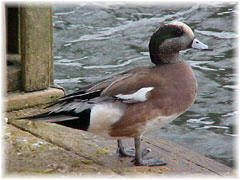 |
||
| American Widgeon Male |
Chiloe
Widgeon:
This South American widgeon is mainly vegetarian, enjoying to graze on
short grass like the other two widgeon species. This is one of few duck
species where the males take part in the rearing and defense of the ducklings.
Silver
Bahama Pintail:
This South American pintail is found only in tropical and subtropical
regions with most species being non-migratory. Remarkably tame in the
Galapagos islands. Sexes have similar plumage.
 |
||
| Silver Bahama Pintail Pair |
Northern
Pintail:
This pintail ranges across most of the northern hemisphere.
Their long necks enable them to exploit slightly deeper water than other
dabbling ducks, also feeding on land where they walk gracefully. Next to
the mallard, the pintail is the most numerous duck in North America.
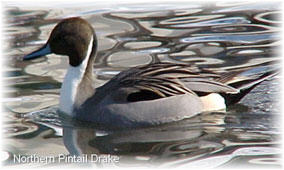 |
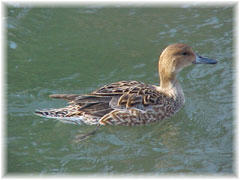 |
| Northern Pintail Drake | Northern Pintail Hen |
Cape
Teal:
African teal with a distinctly pale appearance about the head.
It is closely related to the pintails. The sexes have similar plumage.
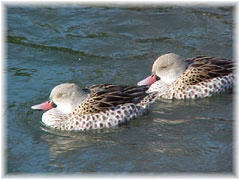 |
||
| Cape Teal Pair |
Hottentot
Teal:
This African teal is the smallest of the dabbling ducks and the only
one with glossy green wings. It is rather sluggish and prefers to swim
away or hide rather than fly. Sexes have similar plumage.
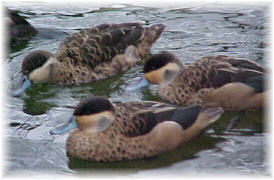 |
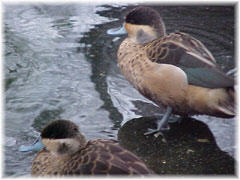 |
| Hottentot Teal Pair | Hottentot Teal Pair |
Silver
Teal:
South American teal who are fresh water ducks and are usually found in
small parties. Feeding on mainly vegetable matter, seeds, or aquatic
plants and some insects. Sexes are similar in appearance.
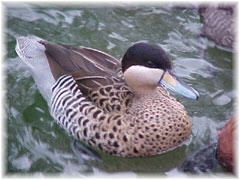 |
 |
| Silver Teal Drake | Silver Teal Hen |
Cinnamon
Teal:
Widely distributed across both North and South America.
Believed to be a link between the blue wing teal and the shovlers. Nest
very well concealed, often with a tunnel of dead grass as an entrance close to
the water.
Argentine
Red Shoveler:
South American shoveler, least awkward of the four species of the
shoveler, with a smaller bill and a long, pointed tail. It is omnivorous.
Northern
Shoveler:
Ranges across most of Europe, Asia, and North America. Most
noticeable is that the bill at the tip is twice as wide as at the base.
The bill is always carried at a downward tilt, even in flight. Shape of
the head is an identification factor.
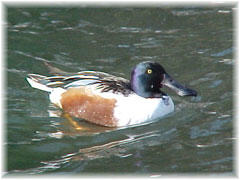 |
||
| Northern Shoveler Drake |
Ringed
Teal:
Central South American species. Very little is known about its habits
in the wild state, where its range is limited to rain forests. It is also
not very numerous. They frequently perch in trees but also nest in tree
holes. Males stay in breeding plumage all year long unlike the northern
waterfowl males.
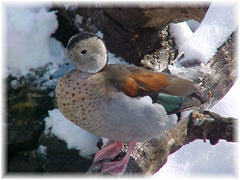 |
 |
| Ringed Teal Drake | Ringed Teal Pair |
New Zealand Shoveler:
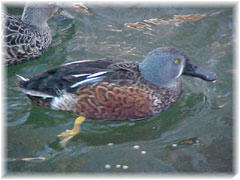 |
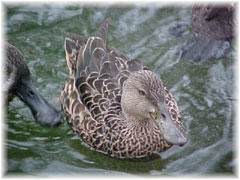 |
| New Zealand Shoveler Drake | New Zealand Shoveler Hen |
![]()
Comments? Questions? Email [email protected].
Copyright � 2003
Last modified: April 02, 2003